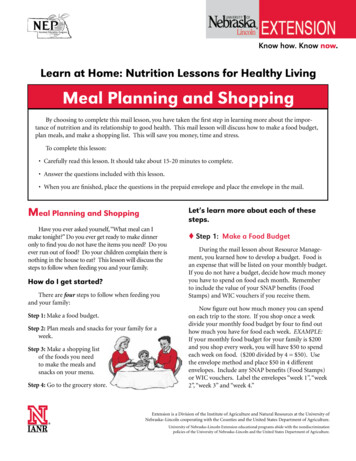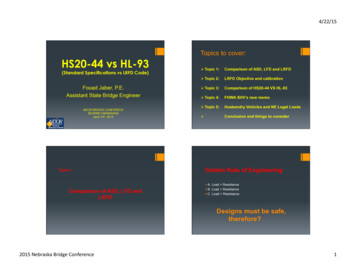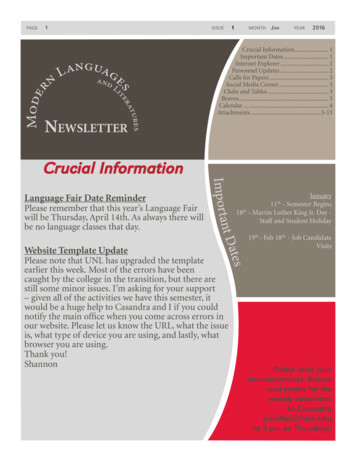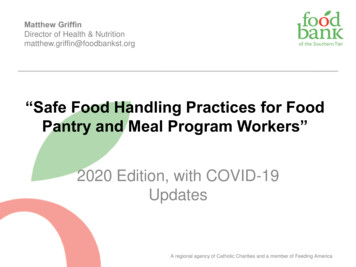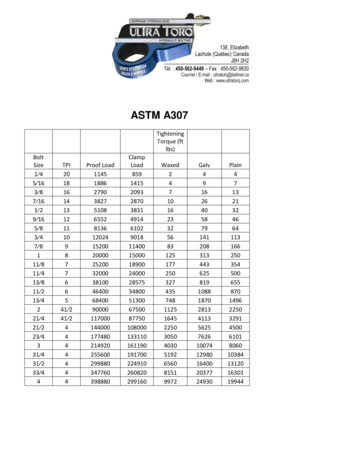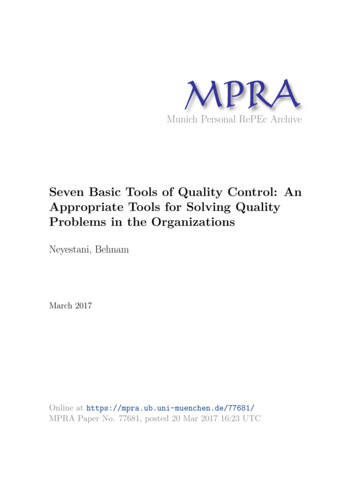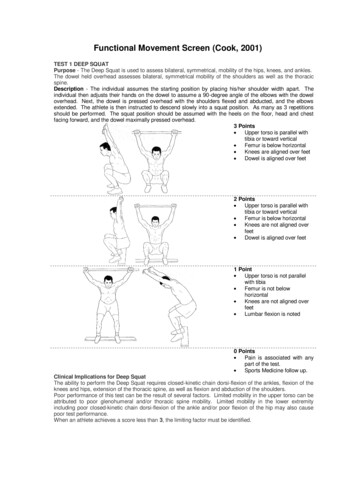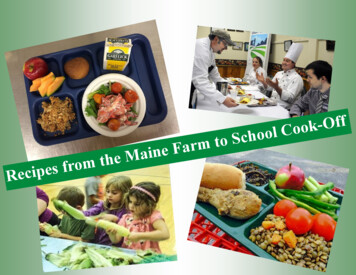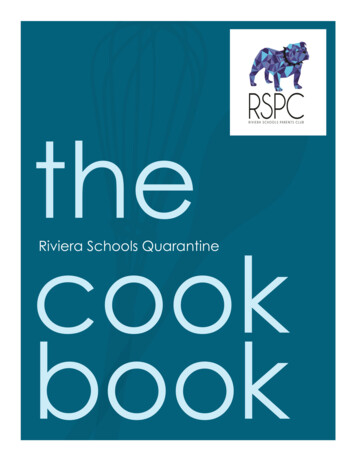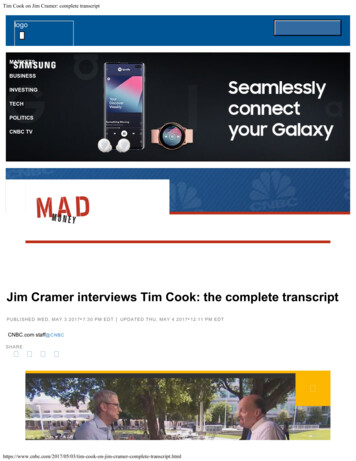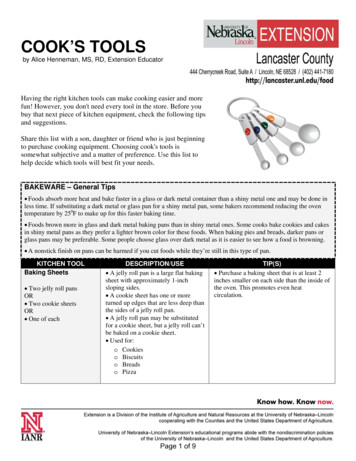
Transcription
COOK’S TOOLSby Alice Henneman, MS, RD, Extension EducatorHaving the right kitchen tools can make cooking easier and morefun! However, you don't need every tool in the store. Before youbuy that next piece of kitchen equipment, check the following tipsand suggestions.Share this list with a son, daughter or friend who is just beginningto purchase cooking equipment. Choosing cook's tools issomewhat subjective and a matter of preference. Use this list tohelp decide which tools will best fit your needs.BAKEWARE – General Tips Foods absorb more heat and bake faster in a glass or dark metal container than a shiny metal one and may be done inless time. If substituting a dark metal or glass pan for a shiny metal pan, some bakers recommend reducing the oventemperature by 250F to make up for this faster baking time. Foods brown more in glass and dark metal baking pans than in shiny metal ones. Some cooks bake cookies and cakesin shiny metal pans as they prefer a lighter brown color for these foods. When baking pies and breads, darker pans orglass pans may be preferable. Some people choose glass over dark metal as it is easier to see how a food is browning. A nonstick finish on pans can be harmed if you cut foods while they’re still in this type of pan.KITCHEN TOOLBaking Sheets Two jelly roll pansOR Two cookie sheetsOR One of eachDESCRIPTION/USE A jelly roll pan is a large flat bakingsheet with approximately 1-inchsloping sides. A cookie sheet has one or moreturned up edges that are less deep thanthe sides of a jelly roll pan. A jelly roll pan may be substitutedfor a cookie sheet, but a jelly roll can’tbe baked on a cookie sheet. Used for:o Cookieso Biscuitso Breadso PizzaPage 1 of 9TIP(S) Purchase a baking sheet that is at least 2inches smaller on each side than the inside ofthe oven. This promotes even heatcirculation.
KITCHEN TOOLBread Pans (sometimescalled “loaf” pans)DESCRIPTION/USEUsed for:o Yeast breads & quick breadso Meatloafo Pound cakesTIP(S) If you don’t have a bread pan, shape yeastbreads and bake directly on a cookie or jellyroll sheet.Used for:o Cakeso Brownieso Rollso Casseroleso Fruit crispso Frozen desserts (if made offreezer-safe material) A 2-inch high pan will help insure yourcakes don’t overflow the pan. Use two 8 x 8 x 2-inch square pans or two 9x 2-inch round pans as a substitute for a 13 x9 x 2-inch pan.oven-proof lids) Usually a deep, round container withhandles and an oven-proof lidOne to three casseroledishes with a size range of½ to 3 quarts, depending onyour cooking needs. Used mainly for baking combinationsof foods such as meats, vegetables,pasta, rice, etc. that are mixed togetherwith some type of sauce. Frequentlyserved as a “one-dish meal.” Casseroles typically are prepared in ceramicor glass bakeware. These materials retain heatwell and are ideal for baking and servingcasserole dishes.Two 9- x 5-inch bread pansCake Pan Two 8- or 9-inch squarecake pans One 13 x 9-inch bakingdishOptional: Two 9-inchround cake pansCasserole Dishes (withCooling RackOne or more large or two ormore smaller cooling racks Used to cool foods after removingthem from a heat source. Available in round, square, andrectangular shapes. Purchase a cooling rack with sturdy wiresthat won’t sag under the weight of heavierfoods. Made of closely placed metal wireson short feet that raise it above thecountertop. This structure allows air tocirculate and cool the food.Muffin Tin(also referred to as muffinpan)12-cup (2 1/2-inches acrossthe top of the cup isstandard size)Pie PlateOne 9-inch pie plate A pan containing individual cups Used for:o Muffinso Cupcakeso Mini-meatloaveso Some types of rolls, such asclover-leaf rollso Individual quiches A round pan with sloping sides Used for:o Pies, quicheso Rollso Deep-dish pizzasPage 2 of 9 A standard muffin tin has cups of about 1/2cup capacity and is the size most often used inrecipes. A 9- by 1 1/2-inch pie plate holds about 5cups while an 8- by 1 1/2-inch pie plate holdsabout 4 cups.
KITCHEN TOOLBlenderColander(sometimes referred to as a“strainer” or “sieve;” see“strainer” for moreinformation)DESCRIPTION/USETIP(S) A blender works well for puréeingingredients, such as for soups, and isterrific for making smoothies andmilkshakes. Though more expensive, glass and stainlesssteel containers are more durable than plasticones. One benefit of glass vs. steel is seeingwhat you’re doing. Buy a heavy-duty blender if you wantto crush ice. Some people like animmersion or hand-held “stick” blenderfor pureeing soups in the pot orwhipping hot chocolate. As a general guideline, never fill thecontainer more than about 2/3 full. If you’ll be blending small volumes of food,buy a blender that is tapered at the bottom. Ablender forces food up against the blenderwalls where it is re-directed back down on theblades and blended until the desiredconsistency. In a blender that is wide at thebottom, small volumes of food will remain inthe bottom of the container and won’t undergothis mixing process. A bowl-shaped container with holesused for draining liquids from solids,such as water from pasta.Made from a variety of materials,including stainless steel, plastic andwire mesh Look for a colander that feels solid andstable when set on a surface. Usually have a footed or ring-typebase at the bottom.Cutting Board Plastic cutting boards are easier tokeep clean as they can be run throughthe dishwasher. Look for a type of plastic cuttingboard that won’t dull your knives.Usually, it will state this on thepackaging materials. Glass or acrylicplastic cutting boards can dull knives. Avoid cross-contamination when cuttingdifferent foods for the same meal. This isespecially important if cutting raw meats,poultry or seafood and then cutting ready-toeat foods. Two possibilities are:o Wash cutting board with hot soapywater and hot rinse water between uses.o Purchase more than one cutting board. If your cutting board doesn’t have non-skidmaterials on the underside, use a damp towelunderneath to prevent it from moving whilecutting.Grater Used for shredding hard foods, suchas cheese and carrots, into smallparticles. Available in several shapes and sizes.Page 3 of 9 Buy a stainless steel grater to avoidproblems with rusting. A box-type grater with a handle at the topmay be the most multi-purpose, havingseveral sizes of holes. To avoid nickedfingers, buy one with a wide base that sitsstably on a surface.
KITCHEN TOOLKitchen TimerDESCRIPTION/USE A digital timer is battery-operated. Itis helpful to have one that times inseconds as well as minutes and hours.Helpful to have a timer that continuesto count after alarm has sounded.TIP(S) If timing several things tasks at one time,may be helpful to have more than one timer.Or, purchase a timer that tracks 2 or morethings at a time. A manual wind-up timer generally isless expensive than a digital one.However, it may offer fewer featuresand doesn’t count in seconds.KNIVES – General TipsThree basic kitchen knives that cover most cutting tasks are a chef’s knife, a paring knife and a serrated bread knife.To help prolong the life of your knives: Many knife companies recommend against washing knives in the dishwasher. This may damage the blade. Woodenhandles may not hold up well when washed in a dishwasher. Always dry the knife before storage Follow manufacturer's directions for sharpening knives. A sharp knife cuts better and is safer than a dull knife.There is a tendency to use too much force with a dull knife, lose control and get cut. Avoid cutting on hard surfaces that dull the edge of your knife, such as glass or acrylic plastic cutting boards.Softer cutting boards, such as polyethylene plastic cutting boards, are much easier on knives. Look for boards thatsay they won’t dull knives.Store knives in a storage system that keeps the blades separate and clean. Do not throw them together in a drawer wherethey can bump against each other and possibly damage or dull the blades. It is harder to keep knives clean in a knifeblock as the slits in the block can’t be washed.Never put a knife in a dishpan with other dishes as it is easy to accidentally cut your finger.Most home knife sharpeners aren’t intended for use with knives with serrated edges. Check manufacturer’s directionsbefore sharpening a knife with a serrated edge. Serrated knives are used on foods requiring more of a sawing motion.They undergo less wear and tear because of their design and generally need less sharpening.KITCHEN TOOLChef’s Knife (also called aFrench Knife)DESCRIPTION/USE Slices, minces and chops foods. Use to cut fresh fruits, vegetables,and herbs. Can be used to cut raw meat andcarve or slice cooked meat. Has broad, tapered shape and finesharp edge. Blade ranges from 6 to 12inches, measures at least 1-1/2 inchesat widest point and is designed to rockon a cutting board as it cuts food.TIP(S) For most people, an 8-inch chef’s knife iseasy to handle. When purchasing, consider:o Does it feel comfortable when you holdit?o Can you easily manage it when goingthrough the motions of slicing andchopping?o Does the blade feel solid, notlightweight and flimsy? Always use with a cutting board. To prevent vegetables and fruits fromslipping on a cutting board, cut these foods inhalf before slicing or chopping further. Thenplace the cut side on the board. This helpsanchor foods firmly on your cutting board andhelps protect against cutting yourself. Often faster to use than a food processor.Page 4 of 9
KITCHEN TOOLParing KnifeSerrated Bread KnifeDESCRIPTION/USE Use for small, detailed work such as:o Peeling fruits and vegetableso Sectioning orangeo Slicing garlico Coring a tomato Blade ranges from 3- to 4- inches.TIP(S) Choose a blade size that feels comfortable inyour hand. Tooth-like edge saws throughfoods with a hard exterior and a softinterior such as:o Breads and cakeso Whole fruits such as oranges and Definitely use a long, serrated knife such asa bread knife for cutting large foods like awatermelon or a cantaloupe. Some people tryto cut large melons with a chef’s knife, whichcan slip easily on these foods.other citrus fruits, melons andtomatoeso Hard-shelled squash Can also be used to:o Shred cabbage & lettuceo Carve or slice cooked meat A common size for most tasks is a 9to 10-inch blade.KITCHEN TOOLMeasuring Cups, DryMeasuring Cups, LiquidDESCRIPTION/USE Usually comes in set of four andinclude a 1/4-, 1/3-, 1/2- and 1-cupmeasure. Some sets include additionalsizes.TIP(S) Measuring cups with handles are convenientfor scooping out ingredients such as sugar,oatmeal, etc. Have a pour spout and a space abovethe last measuring line so liquids don’tspill during measuring and pouring. Never substitute a dry measuring cup for aliquid measuring one. It is easy to spill fluidswhen a dry measuring cup is filled to the top.Most dry measuring cups are made of amaterial that can’t be seen through formeasuring. Made of a see-through material, suchas glass and plastic, for ease andaccuracy in measuring.Measuring Spoons Usually comes in set of four andinclude a tablespoon and a 1-, 1/2-, and1/4-teaspoon. Some sets includeadditional sizes. Use the size of liquid measuring cup closestto the size you are measuring for mostaccuracy. Convenient to have two sets to eliminateneed to rewash them in the middle of foodpreparation. Used for measuring small amounts ofboth liquid and dry ingredients.Mixer(Stand Mixer/HandheldMixer) A stand mixer generally works betterthan a handheld mixer for mixingheavy batters and doughs like breaddough and stiff cookie batters. Stand mixers may be more expensivethan handheld ones.Page 5 of 9 Always turn the mixer off before scrapingdown the sides of a bowl.
DESCRIPTION/USETIP(S)Mixing BowlsKITCHEN TOOL Frequently purchased in a set of 3 ormore bowls. Sizes range from 1 quartto 5 or more quarts. Typically available in glass, plasticand metal. Plastic bowls are unsuitablefor beating egg whites as it is hard towash away any fat that has been in thebowl and this may lessen the volume ofthe beaten eggs. If buying just one set, metal bowls may bemost versatile. Buy stainless steel bowls; theydon’t react to acid like aluminum bowls do. Stainless steel bowls adapt well totemperature changes:o Add ice and water and use as an “icebath” to cool foods like hard-cookedeggs.o Use on top of a saucepan as a doubleboiler. Note: the bowl will get veryhot, so use hot mitts when touching.Mixing Spoons, Large Use a solid mixing spoon for stirringingredients either at the kitchen counteror the stove. Look for a spoon that is easy to handle asmixing spoons are usually around 12 incheslong. Use a slotted spoon when you need tolet liquid drain from food, such asremoving browned, crumbled groundbeef from a pan. If you’ll use the spoon for stirring at thestove, look for a type of material that is heatresistant, such as stainless steel, some of thenewer heat-resistant nylon spoons and wood.For stainless steel spoons, look for a spoonwith a handle that won’t get hot.(Solid and Slotted Heads) For stirring in nonstick cookware, use anonstick or wooden spoon to avoid damagingthe nonstick surface. If using a wooden spoon, be sure it is ingood condition and not cracked or rough onthe surface, making it hard to clean.Pastry Blender (alsocalled a pastry cutter or adough blender) Used for cutting cold fat, such asbutter or shortening, into a flourmixture. Consists of 5 to 6 U-shaped, sturdysteel wires or blades attached to ahandle. For easier mixing, cut cold fat into chunksbefore blending. Typically used when making pastrydough, such as pie crusts. Often used in making crumb crustsand biscuits.POTS AND PANS – General TipsStart your collection of pots and pans by buying just the basics. Add more as needed. In determining the size of askillet, measure across the TOP of the skillet if the size isn’t given. Choose pots and pans made of heavy-gaugematerials — thicker, heav
Having the right kitchen tools can make cooking easier and more fun! However, you don't need every tool in the store. Before you buy that next piece of kitchen equipment, check the following tips and suggestions. Share this list with a son, daughter or friend who is just beginning to purchase cooking equipment. Choosing cook's tools is somewhat subjective and a matter of preference. Use this .
